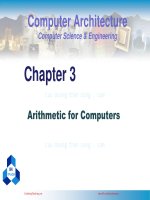kiến trúc máy tính phạm minh cường chương ter2 part3 instructions language of the computer sinhvienzone com
Bạn đang xem bản rút gọn của tài liệu. Xem và tải ngay bản đầy đủ của tài liệu tại đây (1.32 MB, 45 trang )
Computer Architecture
Chapter 2: MIPS – part 3
Dr. Phạm Quốc Cường
Adapted from Computer Organization the Hardware/Software Interface – 5th
Computer Engineering – CSE – HCMUT
CuuDuongThanCong.com
/>
1
Character Data
• Byte-encoded character sets
– ASCII: 128 characters
• 95 graphic, 33 control
– Latin-1: 256 characters
• ASCII, +96 more graphic characters
• Unicode: 32-bit character set
– Used in Java, C++ wide characters, …
– Most of the world’s alphabets, plus symbols
– UTF-8, UTF-16: variable-length encodings
2
CuuDuongThanCong.com
/>
Byte/Halfword Operations
• Could use bitwise operations
• MIPS byte/halfword load/store
– String processing is a common case
lb rt, offset(rs)
lh rt, offset(rs)
– Sign extend to 32 bits in rt
lbu rt, offset(rs)
lhu rt, offset(rs)
– Zero extend to 32 bits in rt
sb rt, offset(rs)
sh rt, offset(rs)
– Store just rightmost byte/halfword
3
CuuDuongThanCong.com
/>
String Copy Example
• C code (naïve):
– Null-terminated string
void strcpy (char x[], char y[])
{ int i;
i = 0;
while ((x[i]=y[i])!='\0')
i += 1;
}
– Addresses of x, y in $a0, $a1
– i in $s0
4
CuuDuongThanCong.com
/>
32-bit Constants
• Most constants are small
– 16-bit immediate is sufficient
• For the occasional 32-bit constant
lui rt, constant
– Copies 16-bit constant to left 16 bits of rt
– Clears right 16 bits of rt to 0
lhi $s0, 61
0000 0000 0111 1101 0000 0000 0000 0000
ori $s0, $s0, 2304 0000 0000 0111 1101 0000 1001 0000 0000
6
CuuDuongThanCong.com
/>
Branch Addressing
• Branch instructions specify
– Opcode, two registers, target address
• Most branch targets are near branch
– Forward or backward
op
rs
rt
constant or address
6 bits
5 bits
5 bits
16 bits
• PC-relative addressing
– Target address = PC + offset × 4
– PC already incremented by 4 by this time
7
CuuDuongThanCong.com
/>
Jump Addressing
• Jump (j and jal) targets could be anywhere
in text segment
– Encode full address in instruction
op
address
6 bits
26 bits
• (Pseudo)Direct jump addressing
– Target address = PC31…28 : (address × 4)
8
CuuDuongThanCong.com
/>
Target Addressing Example
• Loop code from earlier example
– Assume Loop at location 80000
Loop: sll
$t1, $s3, 2
80000
0
0
19
9
4
0
add
$t1, $t1, $s6
80004
0
9
22
9
0
32
lw
$t0, 0($t1)
80008
35
9
8
0
bne
$t0, $s5, Exit 80012
5
8
21
2
19
19
1
addi $s3, $s3, 1
80016
8
j
80020
2
Loop
Exit: …
20000
80024
9
CuuDuongThanCong.com
/>
Branching Far Away
• If branch target is too far to encode with 16bit offset, assembler rewrites the code
• Example
beq $s0,$s1, L1
↓
bne $s0,$s1, L2
j L1
L2: …
10
CuuDuongThanCong.com
/>
Addressing Mode Summary
11
CuuDuongThanCong.com
/>
Synchronization
• Two processors sharing an area of memory
– P1 writes, then P2 reads
– Data race if P1 and P2 don’t synchronize
• Result depends of order of accesses
• Hardware support required
– Atomic read/write memory operation
– No other access to the location allowed between the read
and write
• Could be a single instruction
– E.g., atomic swap of register ↔ memory
– Or an atomic pair of instructions
12
CuuDuongThanCong.com
/>
Synchronization in MIPS
• Load linked: ll rt, offset(rs)
• Store conditional: sc rt, offset(rs)
– Succeeds if location not changed since the ll
• Returns 1 in rt
– Fails if location is changed
• Returns 0 in rt
• Example: atomic swap (to test/set lock variable)
try: add
ll
sc
beq
add
$t0,$zero,$s4
$t1,0($s1)
$t0,0($s1)
$t0,$zero,try
$s4,$zero,$t1
;copy exchange value
;load linked
;store conditional
;branch store fails
;put load value in $s4
13
CuuDuongThanCong.com
/>
Translation and Startup
Many compilers produce
object modules directly
Static linking
14
CuuDuongThanCong.com
/>
Assembler Pseudoinstructions
• Most assembler instructions represent
machine instructions one-to-one
• Pseudoinstructions: figments of the
assembler’s imagination
→ add $t0, $zero, $t1
blt $t0, $t1, L → slt $at, $t0, $t1
move $t0, $t1
bne $at, $zero, L
– $at (register 1): assembler temporary
15
CuuDuongThanCong.com
/>
Producing an Object Module
• Assembler (or compiler) translates program into
machine instructions
• Provides information for building a complete
program from the pieces
– Header: described contents of object module
– Text segment: translated instructions
– Static data segment: data allocated for the life of the
program
– Relocation info: for contents that depend on absolute
location of loaded program
– Symbol table: global definitions and external refs
– Debug info: for associating with source code
16
CuuDuongThanCong.com
/>
Linking Object Modules
• Produces an executable image
1.Merges segments
2.Resolve labels (determine their addresses)
3.Patch location-dependent and external refs
• Could leave location dependencies for fixing
by a relocating loader
– But with virtual memory, no need to do this
– Program can be loaded into absolute location in
virtual memory space
17
CuuDuongThanCong.com
/>
Loading a Program
• Load from image file on disk into memory
1. Read header to determine segment sizes
2. Create virtual address space
3. Copy text and initialized data into memory
• Or set page table entries so they can be faulted in
4. Set up arguments on stack
5. Initialize registers (including $sp, $fp, $gp)
6. Jump to startup routine
• Copies arguments to $a0, … and calls main
• When main returns, do exit syscall
18
CuuDuongThanCong.com
/>
Dynamic Linking
• Only link/load library procedure when it is
called
– Requires procedure code to be relocatable
– Avoids image bloat caused by static linking of all
(transitively) referenced libraries
– Automatically picks up new library versions
19
CuuDuongThanCong.com
/>
Lazy Linkage
Indirection table
Stub: Loads routine ID,
Jump to linker/loader
Linker/loader code
Dynamically
mapped code
20
CuuDuongThanCong.com
/>
Starting Java Applications
Simple portable
instruction set for
the JVM
Compiles
bytecodes of
“hot” methods
into native
code for host
machine
Interprets
bytecodes
21
CuuDuongThanCong.com
/>
C Sort Example
• Illustrates use of assembly instructions for a C
bubble sort function
• Swap procedure (leaf)
void swap(int v[], int k)
{
int temp;
temp = v[k];
v[k] = v[k+1];
v[k+1] = temp;
}
– v in $a0, k in $a1, temp in $t0
22
CuuDuongThanCong.com
/>
The Procedure Swap
swap: sll $t1, $a1, 2
# $t1 = k * 4
add $t1, $a0, $t1 # $t1 = v+(k*4)
#
(address of v[k])
lw $t0, 0($t1)
# $t0 (temp) = v[k]
lw $t2, 4($t1)
# $t2 = v[k+1]
sw $t2, 0($t1)
# v[k] = $t2 (v[k+1])
sw $t0, 4($t1)
# v[k+1] = $t0 (temp)
jr $ra
# return to calling routine
23
CuuDuongThanCong.com
/>
The Sort Procedure in C
• Non-leaf (calls swap)
void sort (int v[], int n)
{
int i, j;
for (i = 0; i < n; i += 1) {
for (j = i – 1;
j >= 0 && v[j] > v[j + 1];
j -= 1) {
swap(v,j);
}
}
}
– v in $a0, k in $a1, i in $s0, j in $s1
24
CuuDuongThanCong.com
/>
Effect of Compiler Optimization
Compiled with gcc for Pentium 4 under Linux
Relative Performance
3
Instruction count
140000
120000
2.5
100000
2
80000
1.5
60000
1
40000
0.5
20000
0
0
none
O1
O2
Clock Cycles
180000
160000
140000
120000
100000
80000
60000
40000
20000
0
none
O3
O1
O2
O3
O2
O3
CPI
2
1.5
1
0.5
0
none
O1
O2
O3
none
O1
27
CuuDuongThanCong.com
/>
Effect of Language and Algorithm
Bubblesort Relative Performance
3
2.5
2
1.5
1
0.5
0
C/none
C/O1
C/O2
C/O3
Java/int
Java/JIT
Quicksort Relative Performance
2.5
2
1.5
1
0.5
0
C/none
C/O1
C/O2
C/O3
Java/int
Java/JIT
Quicksort vs. Bubblesort Speedup
3000
2500
2000
1500
1000
500
0
C/none
C/O1
C/O2
C/O3
Java/int
Java/JIT
28
CuuDuongThanCong.com
/>









